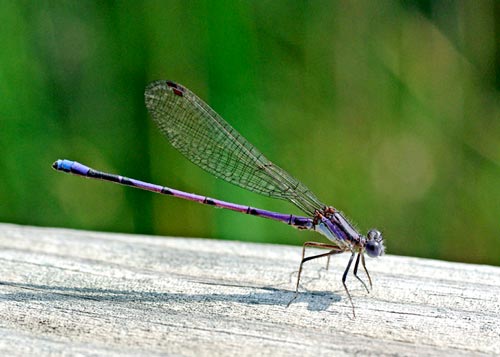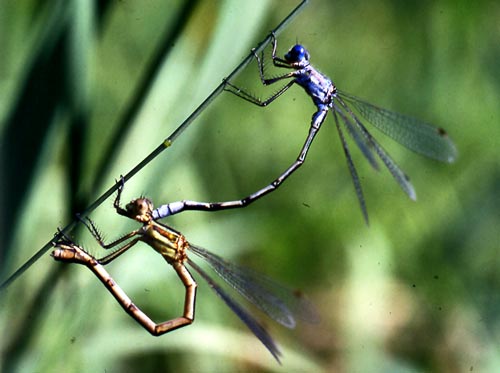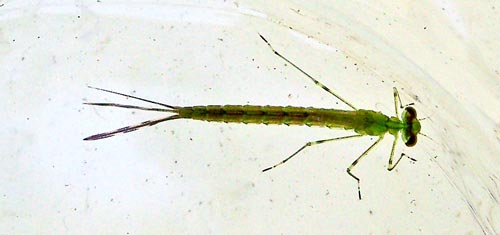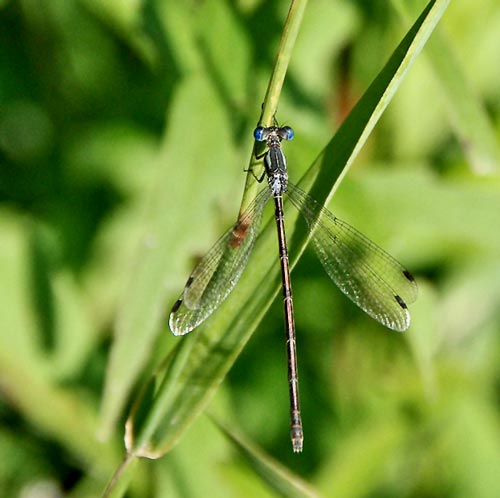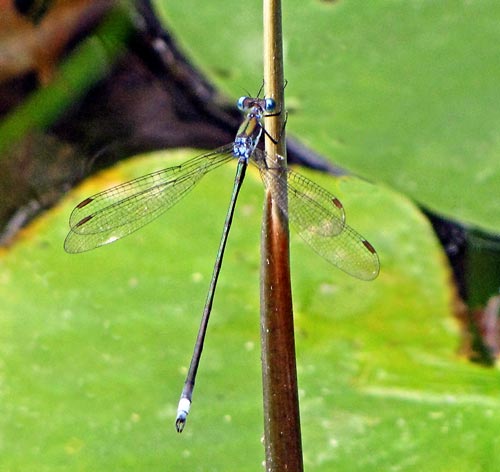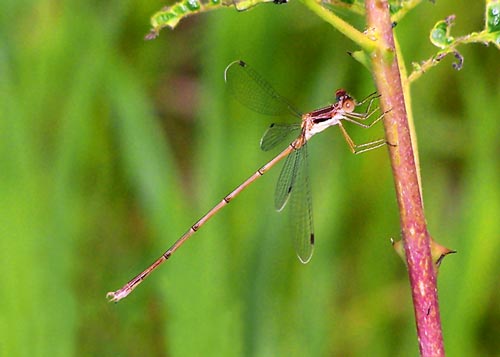Howdy, BugFans,
Damselflies
Damselflies and dragonflies are in the order Odonata (meaning “tooth”). The young of both groups live underwater, and then climb out onto land/vegetation, emerge from their larval exoskeletons, and fly away. They are carnivorous in both stages. Their change in appearance is a bit more dramatic than in other insects that practice simple metamorphosis.
Compared to the (mostly) much larger dragonflies, damselflies look delicate, and their eyes protrude to each side giving them a bug-eyed appearance. A dragonfly’s hind pair of wings is broader than its front pair of wings, but a damselfly’s four wings are roughly equal. And while dragonflies must hold their wings out to the side when they perch, damselflies can fold their wings over their backs (as demonstrated here by the beautiful little Violet Dancer, the BugLady’s favorite damselfly).
There are 23 species of damselfly in Ozaukee County, and 9 of the 23 are members of the inscrutable bluet group. For good information about Wisconsin’s dragonflies and damselflies, including pictures and county lists, check out the Wisconsin Odonata Survey at Wisconsin Odonata Survey. Damselflies are a challenge, both to photograph and to identify. Remember, when identifying damselflies (and dragonflies and butterflies), that they were issued wings but not road maps, and county boundaries mean nothing to them.
The BugLady is especially fond of the lovely Spreadwing damselflies in the family Lestidae, whose members are often seen in late summer and early fall. They perch obliquely or vertically, with wings flattened and half open (spread wings). They are a cosmopolitan (distributed worldwide) bunch, some of whom wear metallic colors. In many species, the males and females are pretty similar in color; the males have blue eyes, and females can be tough to differentiate.
Spreadwings generally hang out on or near the ground by the still/slow-moving, weedy waters required by their naiads (aquatic young) (though the two damselflies caught in flagrante delicto were photographed on the BugLady’s lawn, some distance from water). Naiads of some species have adjusted to the shortened calendar of the ephemeral pond, where the warming temperatures of increasingly shallow waters “goose” their rate of development.
Most dragonflies simply drop their eggs into the water or place them on vegetation or on the lake/pond/stream bed, but damselflies have modified ovipositors that allow them to slit a plant stem and place their eggs inside. The tiny, leggy, newly-hatched naiads eat and molt a dozen or more times on the path to the more familiar naiad forms and later, adulthood (most insects molt five or six times). Lestes naiads can be found sprawling and hunting on vegetation (where they’re well camouflaged). They stalk their prey by day and by sight, extending their long (toothed) labium (lower lip) to scarf up smaller invertebrates. Lestes naiads get around by climbing on plants and by swimming, propelling themselves through the water by swishing their long abdomen and gills back and forth.
The BugLady, who is always interested in the etymology of entomology, found two different stories about Lestes . The Greek meaning is robber, plunderer, or brigand (a reference to their carnivorous habits?), but in French, Lestes means liberated or free (vive la difference).
Slender Spreadwings
Slender Spreadwings (Lestes rectangularis) are found near shaded, permanent ponds and slow streams over the eastern half of the U.S. in July, August and September. The male’s abdomen, proportionally longer than female’s, lacks the light-colored tip of some other spreadwings. Look for the pale veins around the tips of the wings.
Ms. Slender Spreadwing deposits her desiccation-resistant eggs in plant stems above the water level. Partway into their development, still within the egg, the embryos enter a stage of suspended animation called diapause for the winter (Damselflies of the North Woods, by Bob Dubois, refers to this as “egg-wintering.”). When their plant-stem home gets submerged in spring by rising waters or falls over in decay, the embryo resumes its growth. Soon the egg hatches within the stem and the naiad escapes into the water to continue its development. In one study, twice as many Slender Spreadwing females emerged as males. By mid-summer, they are airborne.
Swamp Spreadwings
Swamp Spreadwings (Lestes vigilax) are common from Florida to Texas to Minnesota to Maine and points north. Males’ abdomens have the pale tips that are due to pruinosity (from the Latin for covered by hoarfrost). They are covered with a whitish “dust” that is actually a waxy substance produced by the damselfly. Swamp Spreadwings can tolerate more acidic waters than Slender Spreadwings can. They are not long-distance flyers.
Deposited in the latter half of summer, the eggs of Ms. Swamp Spreadwing develop slowly. By fall, the first-stage naiad exits the stem, drops into the water, and begins a larval stage that lasts for 9 months, until the following spring (larval-wintering).
Fun fact about damselflies—they can land but they cannot walk. As the BugLady approached it, the violet dancer didn’t move but rose higher and higher on its “tip-toes” in preparation for flight.
The BugLady
